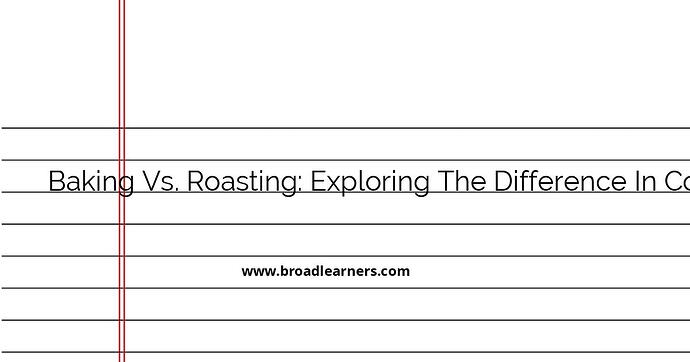When it comes to cooking in the oven, the terms baking and roasting are often used interchangeably, but they are distinct methods that are suited for different types of food. Understanding the difference between these two techniques can help you achieve the best results in your culinary endeavors. In this article, we will delve into the nuances of baking and roasting, exploring what sets them apart, how they each function, and when to use them. We will also provide detailed examples to help you clearly understand both concepts.
- Baking
- Baking is a cooking method that uses dry heat in a closed space, primarily an oven, where the heat surrounds the food item evenly. This technique is most commonly associated with pastries, bread, cakes, and other baked goods, but it can also apply to dishes like casseroles and some proteins.
- Roasting
- Roasting, on the other hand, involves cooking food with dry heat surrounded by hot air, similar to baking, but often at higher temperatures. This method is typically used for meats, poultry, and vegetables, aiming to produce a browned, flavorful surface.
Key Differences between Baking and Roasting
- Temperature: Baking generally utilizes lower temperatures, ranging between 300°F (about 150°C) and 375°F (about 190°C), while roasting operates at higher temperatures, often starting at 400°F (about 200°C) and above, to achieve a crispy texture.
- Food Type: Baking is more suited for batter-based foods like cakes and pastries, whereas roasting works well for solid, dense foods like meats and vegetables where caramelization is desired.
- Methodology: During baking, items are usually placed in the center of the oven to allow even cooking, and moisture retention is often crucial. Roasting may involve placing food on a rack or tray, allowing extension exposure to heat for browning.
Examples Explained
Example of Baking: Baking a Cake
When baking a cake, the batter is made from ingredients like flour, sugar, eggs, and butter, and placed in a well-greased cake tin. The oven is set to a moderate temperature of approximately 350°F (about 175°C). The heat gently cooks the batter, causing it to rise and cook evenly, producing a light and fluffy cake.
Example of Roasting: Roasting a Chicken
In roasting a chicken, the bird is seasoned and placed in a roasting pan. The oven temperature is usually set higher, around 400°F (about 200°C) to 450°F (about 230°C). The high heat crisps the skin and creates a deep, rich flavor while cooking the meat through evenly. Turning or basting it occasionally helps in ensuring even roasting.
Professional Application
Choosing between baking and roasting contributes significantly to the texture and flavor of your dish. For chefs and home cooks alike, mastering these methods can enhance their culinary skill set. By understanding the distinct principles behind baking and roasting, culinary professionals can choose the most appropriate technique according to the food they are preparing, ensuring optimal results and enhancing the dining experience for their guests.
Baking vs. roasting are both essential techniques in the culinary world with their unique applications and subtleties. By selecting the right method, not only can you improve the overall outcome of your dish, but you can also impress with texture and flavor contrasts that delight the palate.
Did I miss anything? Respond below
